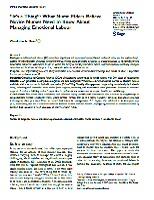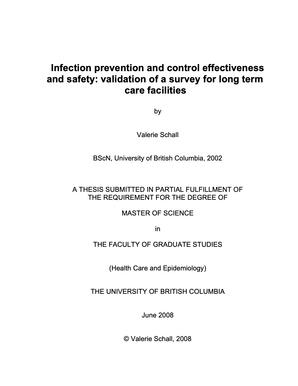Nursing
Related Works
Content type
Digital Document
Description / Synopsis
Advancements in genomics contribute to enhanced disease prevention, diagnosis and treatment. A skilled nursing workforce can ensure patients access safe and equitable genomics-informed healthcare. Policy and professional practice infrastructure are required to support Canada’s nursing workforce in integrating genomics into nursing practice. A coordinated and harmonized national approach is required to accelerate genomics into nursing.
Origin Information
Content type
Digital Document
Description / Synopsis
Nurses can make a significant contribution to genomics services. Policy infrastructure can guide education and leadership to assist nurses to participate in designing new roles and care pathways that address patients' identified needs in the precision oncology era.
Conference poster delivered at <a href="https://icncongress.org/event/220"> International Council of Nurses (ICN) Congress, Helsinki, Finland (June 9-13, 2025).</a>
Origin Information
Content type
Digital Document
Abstract
Background
Emotional labour (EL) can take a significant toll on nurses’ mental health and well-being and has serious implications for the retention of nurses in the workforce. Nurse educators have struggled to prepare novices to manage EL or find serviceable resources with which to do so within the body of nursing literature, which is dominated by essentially unhelpful narratives and is absent of the practical, real-world wisdom of elder nurses.
Purpose
This exploratory research study illuminated elder nurses’ experiential knowledge and beliefs of what is important for novices to learn about EL.
Methods
Conventional Content Analysis (CCA) of qualitative survey data from 688 nurses with 20+ years of experience.
Results
CCA generated descriptive categories and sub-categories: What the elders themselves learned as student nurses, and their advice to novices in the individual realm, (“It's a Thing,” healthy disengagement, supporting mental and physical well-being, reframing self-reproach), team realm (peer support, mentors), and institutional realm (structural barriers to mentors’ support of novices, building novices’ capacities for self-advocacy, resources to support health and well-being).
Conclusions
The elders’ data confronted and reframed legacy individuated narratives in the literature by supporting and contextualizing nurses’ emotional work. Elders advised novices that EL is a reality requiring concrete strategies to manage it throughout their practices. Elders extended their focus for management of EL beyond the individual to include peer support, mentorship, and the structural conditions in which nurses perform their EL, highlighting the need to empower nurses by building their capacity for self-advocacy of their workers’ rights.
Origin Information
Content type
Digital Document
Abstract
The purpose of this study is part of a larger three-phase project to develop recommendations and catalyze action for genomics-informed oncology nursing education and practice for the Canadian Association of Nurses in Oncology and the Canadian Association of Schools of Nursing. This phase aimed to enhance understanding of policy needs and action drivers for genomics-informed oncology nursing education and practice through the perspectives of Canadian oncology nurses and patient partners.
Origin Information
Content type
Digital Document
Abstract
How do new emergency nurses describe their experiences as they make the transition from being a new to becoming a more experienced emergency nurse? What are the needs of new emergency nurses as they make this transition? In this qualitative study, new emergency nurses were interviewed for the purpose of identifying what is was like to be a new nurse in the emergency department; what were their needs; what health care personnel, educators and administers could do to help them; and their intent to leave. Interpretive description was the research approach utilized in this study. Ethical approval was obtained from the University of British Columbia Behavioural Research Ethics Board and the Fraser Health Clinical Investigation Committee. Using theoretical sampling, eight new emergency nurses, from the lower mainland and Vancouver Island of British Columbia, participated in semistructured, audiotaped interviews. They had three years or less of emergency nursing practice and had completed the core courses of an emergency specialty program. The new emergency nurses felt overwhelmed and unprepared as they started their emergency practice. They encountered inconsistencies and deficiencies in their orientation programs. They encountered factors in the workplace environment that created challenges for them to practice safely and ethically. Workplace challenges included: the nursing shortage; the lack of resources; frustrations with management; the high patient acuity and volume; the challenges of attempting to meet organizational and technical changes; and the expectations of patients and patient's families. Hospital overcrowding created an environment where the nurses experienced occupational stress; mental and physical fatigue plus abuse from patients, patient families and emergency personnel. The participants did not utilized professional services to debrief stressful incidents. They described favourable relationships with emergency physicians and experienced horizontal violence from nursing colleagues. Six of the eight participants anticipated leaving the emergency department or changing their status in a year. They expressed feelings of being frustrated, stressed, overwhelmed and exhausted. The study's findings suggest implications for policy makers, nursing practice and nursing education. Further research is needed to explore the experiences of emergency nurses, the work place environment, the abuse they encounter and strategies to retain them.
Origin Information
Content type
Digital Document
Abstract
The learning initiative called the British Columbia Nursing Administrative Leadership Institute (BCNLI) for first line nurse leaders was developed to address the need for educating and mentoring new nurse leaders. The program was a joint project between the Ministry of Health Services Nursing Directorate, British Columbia’s Chief Nursing Officers and the School of Nursing at UBC. The BCNLI program is evidenced based and included information on leadership, management concepts and relevant issues for leaders, (MacPhee & Bouthillette, 2008). The front line nurse leaders who participated were provided education and mentoring, to increase their skills. The front line nursing leaders selected year long projects as part of the program. This study examined if there was any change to the types and scope of control of projects front line nurse leaders chose as part of learning and mentoring initiative. 211 nurse leaders’ projects from the BCNLI project data web pages were examined for scope of control, type of project, and Donabedian’s (1982) structure process outcomes framework using content analysis (Graneheim & Lundman, 2004). These projects provide a window to the types of issues that were relevant and seen as important to the front line nurse leader participants in each cohort of the BCNLI program from 2007 to 2010. This research found that there was no change between the nine cohorts as to structure or process coding. The majority of the projects were structure coded. The content analysis identified five main themes of recruitment/retenton, communication, education, care delivery evaluation, and tool development. The ability to identify the scope of projects of front line nurse leaders was important as very little research exists on scope of control for front line nurse leaders. Only 61% of the projects are at the nursing unit or front line (level two) position. There are concerns that front line nurse leaders were working beyond the nursing unit level. This research will help to understand if nurse leaders are taking on issues or problems that are beyond their roles and the type of projects that exist in the British Columbia Health Care.
Origin Information
Content type
Digital Document
Abstract
There is a common expectation among health care professionals to "do no harm" and, while this is the ideal, it is not the reality. Despite the best intentions of health care professionals, errors do occur. The objectives of this review were to explore how health care professionals were affected by their involvement in adverse events and to determine the types of support health care professionals required after making an error. An integrative literature review of eleven research articles was conducted to explore common themes. These eleven studies included four quantitative studies, six qualitative studies, and one mixed-methods study. The results of this literature review indicate that following an error, health care professionals experience emotional distress on both a personal and a professional level. Health care professionals require individual as well as organizational support to help them cope with the error. The findings of the integrative literature review have important implications for nursing practice, nursing leaders and advanced practice nursing.
Origin Information
Content type
Digital Document
Abstract
Health personnel, especially nurses, are often victims of workplace violence. Unfortunately, little is known about the nurses' experience of violence. A research study was initiated to further explore the nurses' accounts of workplace violence so as to make dimensions of the nurses' experience visible and more fully understood. Interpretive description was the research methodology adopted for this study. Using theoretical sampling, ten Registered Nurses from the lower mainland and Vancouver Island, British Columbia participated in semi structured, audiotaped interviews. In this research, the nurses' experience of workplace violence emerged as a highly complex entity, deeply embedded in relationships and context. How nurses perceive the contextual factors of the organization, their immediate work environment and their individual attributes were found to play a significant role in how they respond to the phenomenon. The findings of this study suggest that organizational culture is an important determinant in managing workplace violence and that policy and administrative personnel play a pivotal role in influencing the problem. Nursing culture also influences the nurses' expectations, assumptions and actions towards violence. Participants voiced that role conflict often challenged their ability to enact acquired professional ideals and that that they routinely undertake roles in dealing with violence that are not appropriate to their level of knowledge or skill. Within the nurses' immediate work environment, bullying as well as physical and verbal abuse was commonplace. Overcrowding, long waits for service, poor environmental design and inadequate staff to patient ratios were seen as factors that increased nurses' risk. Individual factors were associated with emotional and psychological harms that nurses endured. Workplace violence affected self-concept, self-esteem, self-efficacy and the nurses' sense of control. Moral distress, self-blame, feelings of failure, loss of motivation and leaving the nursing profession were significant findings. The results of this study demonstrate a need to re-think how we can address workplace violence in nursing. Research and intervention is needed to further explore organizational policy and governing structures, the culture and climate of practice environments, and the fundamental role nursing education programs have in preparing nurses to manage workplace violence.
Origin Information
Content type
Digital Document
Abstract
Objectives
First to develop a short survey based on the 2004 Health Canada / Public Health Agency of Canada recommendations for key infection prevention and control (IP&C) structures and processes in long term care facilities and the five Institute of Medicine safety principles published in ‘To Err is Human’ (2000). Then, to establish the validity and feasibility of the survey when used to describe key IP&C structures and processes in LTC facilities within the context of the five safety principles.
Methods
This study was designed using a three-phase methodology. During Phase I, a conceptual model for IP&C was created to develop six structural and process composite indices. The concepts and components covered within each index were developed based on the 2004 Public Health Agency of Canada recommendations for IP&C programs in the LTC setting and a thorough literature review. During the second phase of the study, a group of 7 experts in LTC IP&C were recruited from BC’s Provincial Infection Control Network to validate and further develop the survey and one of these dropped-out at the beginning of the process. The five Safety Principles published in 2000 by the Institute of Medicine were also provided to the experts so they could be used to complement and further develop the concepts covered by the survey. The Delphi methodology was used in this phase of the study so that experts may reach consensus on modifications made to survey questions. The Delphi phase began in April and ended in October 2007; 114 worksheets were sent to experts to support the consensus-reaching process. Consensus was defined as 67% concordance of opinions and experts were given almost unlimited time to respond to worksheets. Once the validity of new survey questions had been established based on expert-group consensus in Phase II, a second draft of the survey was prepared and pilot-tested in Phase III. An invitation letter was sent to a random sample of 20 LTC facilities stratified by facility ownership and governance structure in Fraser Health. The 14 facility Senior Managers who agreed to participate were sent a cover letter and electronically fillable survey. An analysis of the validity of the survey questions and the feasibility of the use of the survey in a larger study was performed, and revisions were made to the survey based on the findings of this analysis.
Conclusions
The three-phase methodology used in this study was very useful and innovative way to further develop and validate the literature-based survey developed in Phase I for IP&C in long term care. In addition, by merging two bodies of knowledge and thought into the process, concepts and components that are not explicitly described in IP&C literature yet were felt to be key in program success, were incorporated into the measurement tool. Using Delphi, the experts expressed a need for IP&C professionals working in LTC to increase their knowledge, understanding and use of safety theory and strategies. They also felt that interdisciplinary work, the development of a culture of safety, and the development clear and simple IP&C systems are key ways in which infections can be prevented and outbreaks quickly controlled. In Phase III, the pilot-study analysis demonstrated the utility, validity and reliability of the survey. In addition, the analysis showed that there is a tendency for facilities to have lower levels of components within the Leadership Index and the ICP Index. If confirmed in a larger study, this would be a major concern as all studies and expert advisory bodies for both IP&C and safety state that a strong, dedicated and knowledgeable leadership is the key to program effectiveness. Further validation of the survey and score calculation methodology should now be performed when the survey is used in a larger study.
Origin Information
Content type
Digital Document
Abstract
This descriptive study investigated mothers' perceptions of and responses to neonatal crying behavior for the purpose of providing more relevant and effective nursing care to mothers with young infants. With the guidance of an interactive framework, quantitative and qualitative data were collected at three different time periods in the first postpartum month from 19 primiparous women who delivered healthy full term infants. Findings indicated that on the third postpartum day neonatal crying behavior was not an anticipated caregiving concern for any of the mothers. By the fourth postpartum week, however, 9 of the 19 mothers rated crying as a concern and had recorded significantly more crying behavior than the 10 mothers for whom crying was of little or no concern. Data revealed that the infants whose crying was of less concern were more content, consistently consolable, gave clearer cues regarding distress and comfort and had more easily definable and more compatible behavioral patterns than the infants whose crying was a concern. Mothers with little or no concern about their infant's crying differed from those with concerns in that they expected more crying behavior, perceived crying more positively, and were more prompt in their response to signs of distress. There were also statistically significant differences in that mothers with little or no concerns about crying were less concerned about spoiling their infant and experienced neonatal crying as a less negative influence on their feelings of maternal confidence. As a total group, the mothers' interpretations and responses to neonatal crying behavior were empiric and reflective of little academic or experiential preparation for understanding and managing neonatal crying. Mothers' expectations and health professionals' responses support a societal belief that mothering is intuitive, instinctive and to be learned "on the job." Findings indicate that the perinatal nurse needs to anticipate neonatal crying as a caregiving concern of mothers with young infants and must know and utilize current theory associated with infant crying and maternal-infant interaction. The nurse must participate in the generation and subsequent promotion of innovative nursing interventions to decrease mothers' concerns about and increase their management of neonatal crying behavior.
Origin Information








